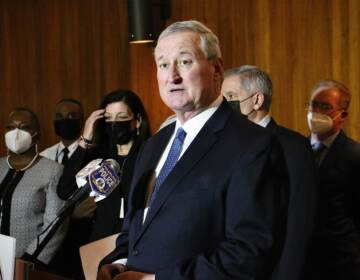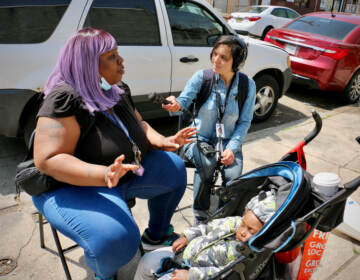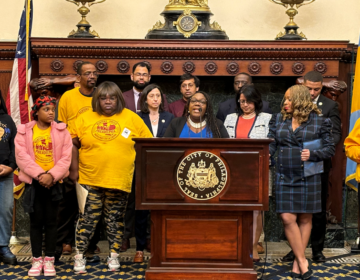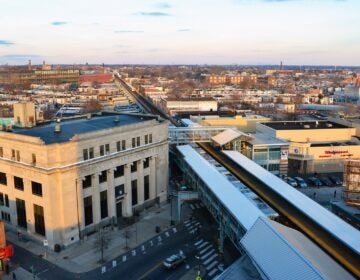Philly’s new anti-violence plan funds policing, youth safe havens, and environmental improvements. Advocates say strong implementation will be key
Philadelphia’s budget for fiscal year 2023 funds neighborhood improvements, creating safe youth spaces in an effort to combat the city's gun violence crisis.
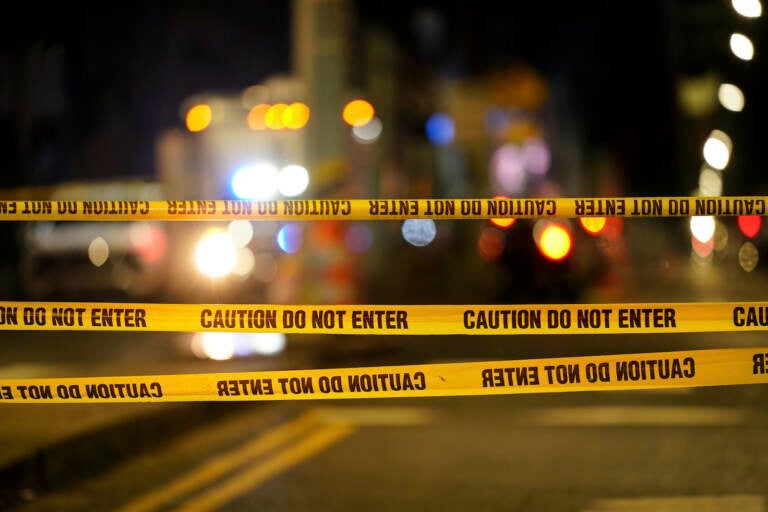
File photo: Tape cordons off the area around a shooting in Philadelphia, Wednesday, April 6, 2022. (AP Photo/Matt Rourke)
The city of Philadelphia’s $5.8 billion budget for fiscal year 2023 includes $184 million for gun violence initiatives, as well as a nearly $30 million boost for the Philadelphia Police Department. The violence prevention plan emphasizes a combination of law enforcement strategies, environmental improvements, youth programs, and help for victims to reduce the city’s growing homicide numbers.
While there are promises for new initiatives, such as support for criminal justice-involved youth and behavioral health services for potential shooters, many residents are looking for more urgency and investment given the scale of the crisis.
There have been just over 1,100 shooting victims in Philadelphia this year, and about one-fifth of them died by gunfire. Last year, homicides reached a record high of 562 in the city, and 85% were caused by guns.
Following an early June mass shooting that injured 11 and killed three on South Street, gun violence activists have continued protesting on the streets and meeting with City Council members to criticize what they feel is a failing effort to effectively stop the bloodshed.
Victoria Wylie, who coordinates a support group for shooting survivors in honor of her brother Donte Wylie, said the city’s investments in violence prevention in recent years have not gone far enough.
“When we make small investments, it’s this idea that ‘we gave them something,’” she said. “We’re appreciative of ‘the something,’ but we want all of it. We need what we need to make things change.”
The mayor’s office said in a statement that the budget for fiscal year 2023 will continue to address the root causes of gun violence “through an array of strategies focused on community empowerment, employment and careers, healing, prevention, and safe havens for children and youth.”
Councilmember Kenyatta Johnson, chairman of the City Council Special Committee on Gun Violence Prevention, said the budget isn’t an overnight solution to the crisis. It’s a continued, three-pronged approach involving prevention, intervention, and enforcement.
“It doesn’t have to be an either/or,” he said. “It can be an ‘and.’”
Here’s a breakdown of some of the major themes in the city’s plan for gun violence prevention.
Policing
The Philadelphia Police Department originally asked for a $23.7 million increase to their budget, mostly to fund contractually obligated wage increases. City Council introduced additional funding for police recruitment and a community policing strategy.
Based on Kenney’s initial proposal alone, the city spending on policing per person would be $476 — a $26 per person increase from 2016. That’s compared to $42 per person on Parks and Recreation, and $35 per person on libraries, which many activists see as important components of gun violence prevention.
Emily DeCarlo, youth violence outreach director with the nonprofit Anti-Violence Partnership of Philadelphia, said policing is important but it doesn’t build community the way community centers and libraries do.
“Prevention is in fact including things like youth programming, including things like schools, including things like parks and rec and programming for youth in the out-of-school time hours,” she said. “We need to find the right balance for that.”
The city’s investment plan released this spring laid out several ongoing law enforcement-involved programs intended to curb violence:
- The Group Violence Intervention program, which works with individuals engaged in violence and with law enforcement to discourage criminal behavior. The program will grow from three to 12 case managers. Many criminal justice scholars consider it an evidence-based public health approach to gun violence.
- Police-assisted diversion, which diverts low-level, non-violent offenders away from the criminal justice system and toward support services, will expand into the Northeast Police Division.
- The department will launch a gun homicide review and expand the nonfatal shooting review, to examine the causes of shootings and identify trends and interventions.
The city continues to lift up its Operation Pinpoint program, which concentrates policing in “hotspot” areas affected by violence. The police department says homicides are down 11% and shooting victims are down 6% in those areas as of June 19, compared to the year prior. There is some research supporting this policing strategy, but overall, the research on increased policing is mixed and many experts argue there are better ways to reduce gun crime.
Environmental improvements
City Council added $28 million to the budget for “placemaking efforts,” which they hope will reduce crime by improving quality of life on a neighborhood level. Some research has shown a correlation between interventions such as home repairs and greening vacant lots and crime reduction.
Those environmental investments include:
- $5 million for expanding the Community Life Improvement Program
- $1 million for Licenses & Inspections Clean & Seal, Demolitions
- $2 million for abandoned vehicles
- $2 million for short dumping
Terrill Haigler, a former sanitation worker who now advocates for environmental improvements as violence prevention under the moniker “YaFavTrashman,” said he’s excited about the additional funding for the CLIP program, which helps community members organize their own cleanup events.
“Your environment affects you emotionally and mentally, so you’re waking up to filth every single day,” he said. “There’s only going to be a negative effect on a mentality and a negative effect on your emotions.”
He said he was hoping the city would set aside funding to create an illegal dumping task force, to get more trucks and sanitation workers on the streets to improve the turnaround time for pickups.
The new budget also includes investments in street lights and security cameras.
Youth programs and safe spaces
Both the mayor’s proposal and City Council’s additions address the need for programs serving young people, particularly those who are considered at-risk for getting involved in gun violence later in life.
That includes another $12 million for the Anti-Violence Community Expansion Grant program, which funds gun violence prevention efforts run by nonprofit groups. The program also received a $13.5 million investment in the 2022 budget. A similar city-run violence prevention grant program designed to help nonprofits has experienced significant hold-ups in funding distribution.
The budget for fiscal year 2023 includes $2.5 million to keep recreation centers with gyms open on weekends, which DeCarlo at the Anti-Violence Partnership said could make a meaningful impact.
“If the space is usable, then other nonprofits in the city could also use it to offer programming, and then I think the kids will come,” she said. “They’re around. They’re on the basketball courts, they’re on the playgrounds. It’s just about opening the doors and saying come in and talk to us.”
She said ensuring that the rec center funding is used in a way that actually has an impact on youth will require working with neighborhood groups to design programming that is appealing to them.
Victim Services
Both homicides and nonfatal shootings have a long-lasting impact on victims, their loved ones, and neighborhood residents indirectly affected by violence.
“It’s not like a bullet only hurts the person that it hits. It hurts communities, generations, all of us,” said Victoria Wylie, of the Donte Wylie Foundation. “I don’t care how much money they add to it, it’s probably not enough.”
The budget includes some support for those experiencing trauma related to violence, including:
- $500,000 for the Office of the Victim Advocate
- $100,000 for a Domestic Violence Hotline
- $5.8 million for the Defender Association
The Kenney administration says fiscal year 2023 will mark an expansion of restorative justice diversion, in which young people who have caused harm or been harmed by gun violence undergo a supervised reconciliation process.
Some research suggests that having been shot is one of the biggest predictors for becoming a shooter. Wylie said building a system that addresses the effects of gun violence comprehensively could prevent the victimized from becoming victimizers. She also said there’s an enormous need for housing, mental health help, and other support for survivors.
“A person gets shot, they may be contacted around the time they’re injured,” she said. “But what happens ten years after their injury? Even if you heal, the trauma and the grief and the pain and the anger that you feel from being shot remains.”
The budget also includes funding to improve street outreach programs, expand employment training and pilot a version of the READI program, a model out of Chicago which combines therapy and job-finding assistance.
If you or someone you know has been affected by gun violence in Philadelphia, you can find grief support and resources here.
WHYY is your source for fact-based, in-depth journalism and information. As a nonprofit organization, we rely on financial support from readers like you. Please give today.


